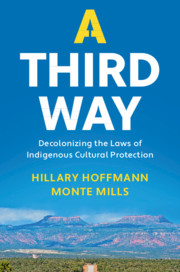Book contents
- A Third Way
- A Third Way
- Copyright page
- Dedication
- Contents
- Figures
- Preface
- Acknowledgments
- Introduction
- 1 Legal History and Foundations
- 2 The Jurisdictional Framework of the Second Way and the Cherokee Diaspora
- 3 Religious Freedom, the Value of Sacred Places, and the Price of Cultural Ignorance
- 4 Clashing Values, the Blackfeet, and a Measure of Success in the Badger-Two Medicine
- 5 Federal Cultural Protection Statutes
- 6 Tribal Laws
- 7 Both Ends of the Spectrum and Everything in Between
- 8 Indigenous Cultures and Intellectual Property
- 9 A Third Way for the Future
- Index
7 - Both Ends of the Spectrum and Everything in Between
State and Local Governments and Indigenous Cultures
Published online by Cambridge University Press: 16 July 2020
- A Third Way
- A Third Way
- Copyright page
- Dedication
- Contents
- Figures
- Preface
- Acknowledgments
- Introduction
- 1 Legal History and Foundations
- 2 The Jurisdictional Framework of the Second Way and the Cherokee Diaspora
- 3 Religious Freedom, the Value of Sacred Places, and the Price of Cultural Ignorance
- 4 Clashing Values, the Blackfeet, and a Measure of Success in the Badger-Two Medicine
- 5 Federal Cultural Protection Statutes
- 6 Tribal Laws
- 7 Both Ends of the Spectrum and Everything in Between
- 8 Indigenous Cultures and Intellectual Property
- 9 A Third Way for the Future
- Index
Summary
Hawaii and Vermont illustrate many of the themes surrounding indigenous peoples’ relationships with the states in which they reside, sometimes dating back long before the ratification of the US Constitution. Vermont was the fourteenth state admitted to the Union, and by 1791, the year of its admission, the lands within its boundaries had been home to indigenous peoples since as early as 11,000 CE and perhaps before. The state keeps no historical records about indigenous populations, language groups, or virtually any other information that might assist a tribal historian to piece together the history of one or more of the local indigenous people, which complicates the matter of recounting the state’s historic relationship with indigenous cultures. As of the twenty-first century, there are approximately 2,000 people living in Vermont who identify as indigenous on census surveys, and these are mostly members of different bands of Abenaki in the northern part of the state.
- Type
- Chapter
- Information
- A Third WayDecolonizing the Laws of Indigenous Cultural Protection, pp. 113 - 131Publisher: Cambridge University PressPrint publication year: 2020



